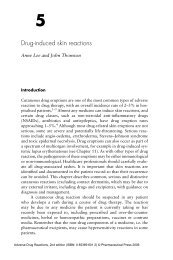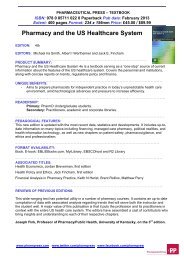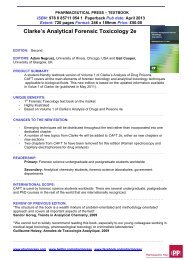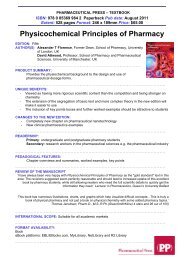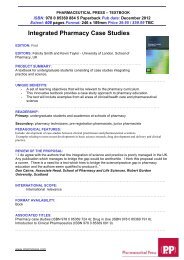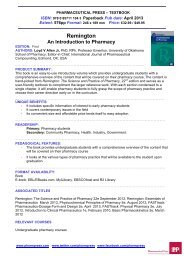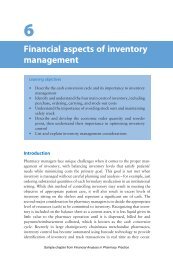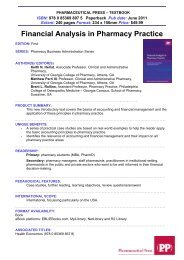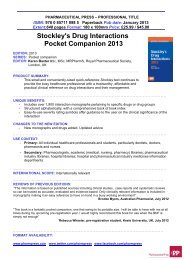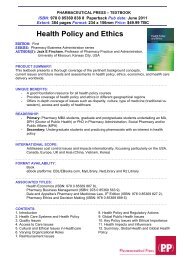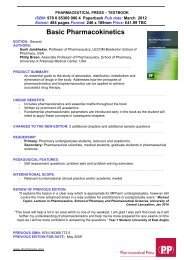1 Introduction to traditional medicine - Pharmaceutical Press
1 Introduction to traditional medicine - Pharmaceutical Press
1 Introduction to traditional medicine - Pharmaceutical Press
Create successful ePaper yourself
Turn your PDF publications into a flip-book with our unique Google optimized e-Paper software.
10 | Traditional <strong>medicine</strong><br />
Europe<br />
Unfortunately, at the present time it is generally recognised that regulation<br />
of <strong>traditional</strong> systems of <strong>medicine</strong>, the products used in <strong>traditional</strong> systems<br />
and the practitioners of these systems is very weak in most countries. 21<br />
Despite being made up of 27 European Member States in which a significant<br />
proportion (at least 33%) of the population use non-orthodox <strong>medicine</strong><br />
(including <strong>traditional</strong> <strong>medicine</strong>) as part of their healthcare provision,<br />
the EU currently has hardly any policies that specifically refer <strong>to</strong> <strong>traditional</strong><br />
therapies. In 1997 the European Parliament adopted a resolution that called<br />
for steps <strong>to</strong> regulate and promote research in ‘non-conventional <strong>medicine</strong>’,<br />
including Chinese herbal <strong>medicine</strong> and shiatsu. 22 The report’s rapporteur,<br />
Paul Lanoye MEP, was so disappointed in the way that the report had been<br />
weakened by negative amendments that he abandoned it at the last minute<br />
and forced the Parliament’s Chairman at the time, Mr Collins, <strong>to</strong> add his<br />
name <strong>to</strong> it <strong>to</strong> enable it <strong>to</strong> be adopted.<br />
One of the main reasons for this is that the EU Treaties are worded so as<br />
<strong>to</strong> protect the area of healthcare delivery as the responsibility of individual<br />
member states.<br />
The lack of regulation leads <strong>to</strong> misuse of the <strong>medicine</strong>s by unqualified<br />
practitioners and loss of credibility of the system. In <strong>traditional</strong> <strong>medicine</strong>,<br />
practitioners and manufacturers (particularly the small ones) usually oppose<br />
any steps <strong>to</strong> strengthen regulation by the health administration. Their fears<br />
are that regulation such as applies <strong>to</strong> allopathic <strong>medicine</strong> is not suitable for<br />
<strong>traditional</strong> <strong>medicine</strong>. The World Health Organization has initiated an effort<br />
in this direction and may be the appropriate body <strong>to</strong> help countries not only<br />
<strong>to</strong> develop a regula<strong>to</strong>ry system but <strong>to</strong> take steps <strong>to</strong> meet the obligations under<br />
the Trade-related Intellectual Property Rights Agreement, when this became<br />
applicable in developing countries in 2005. It means that <strong>traditional</strong> healers<br />
(hakkims) who have come <strong>to</strong> the UK may practise within a culture that is<br />
oblivious <strong>to</strong> the highly regulated status of western <strong>medicine</strong>. Healthcare<br />
providers should be vigilant <strong>to</strong> ensure that any risks <strong>to</strong> patients are<br />
minimised.<br />
All the foregoing may seem <strong>to</strong> indicate that integrating <strong>traditional</strong> and<br />
western <strong>medicine</strong> is at best difficult and at worst impossible. Most of the<br />
remarks in this chapter are directed at Chinese and Asian <strong>medicine</strong>, these<br />
two systems being the two <strong>traditional</strong> disciplines that health care providers<br />
are most likely <strong>to</strong> meet in the UK. It should be noted that <strong>traditional</strong> <strong>medicine</strong>s<br />
in other cultures also flourish and many are integrated in<strong>to</strong> local<br />
healthcare. In their own countries Australian Aboriginals, 23 New Zealand<br />
Maoris, 24 North American Indians, 25,26 Africans, 27,28 Pacific Islanders 29 and<br />
the peoples of Latin America 30 continue <strong>to</strong> make important contributions <strong>to</strong><br />
their national cultures and fulfilling healthcare needs.<br />
Sample Chapter from Traditional Medicine



